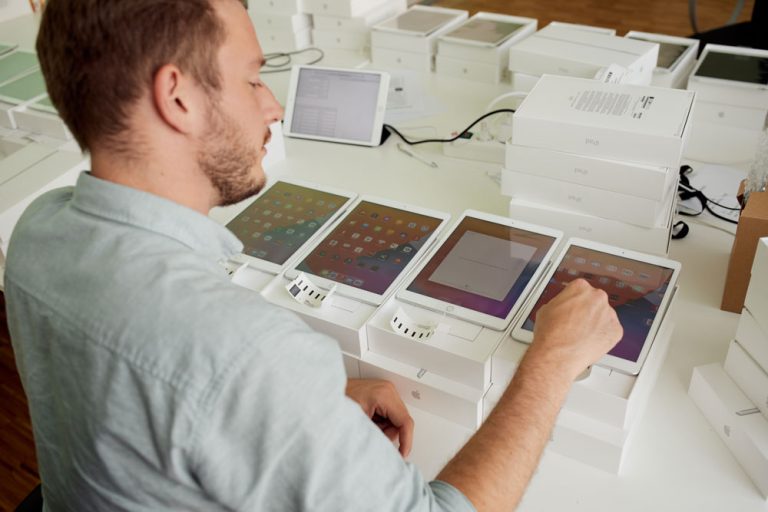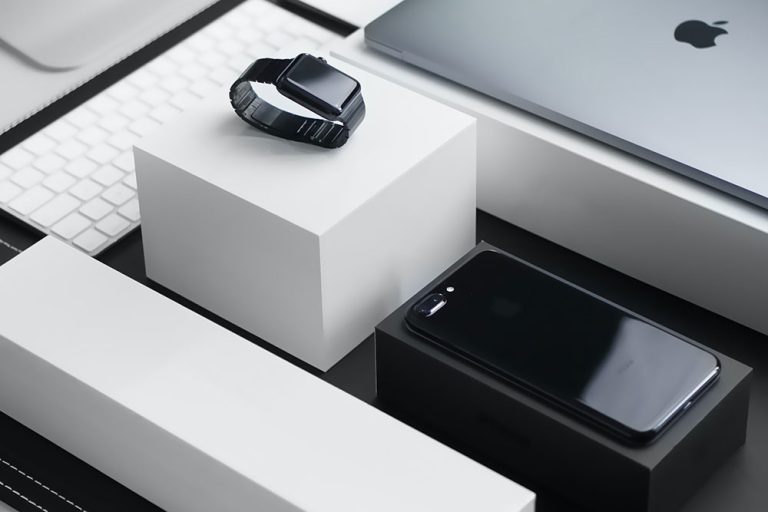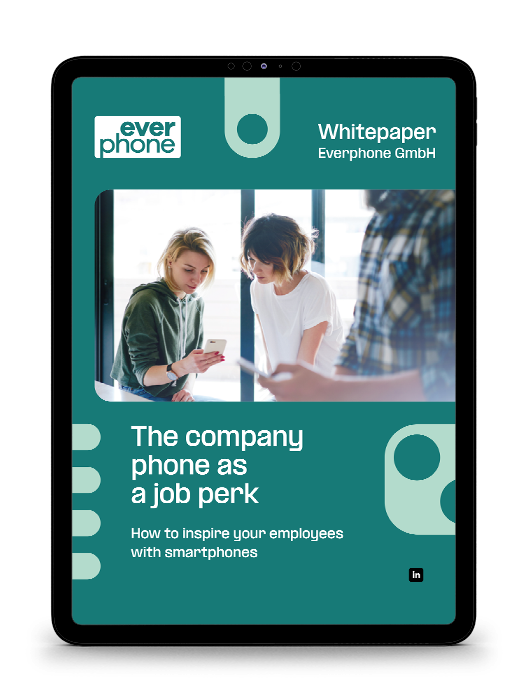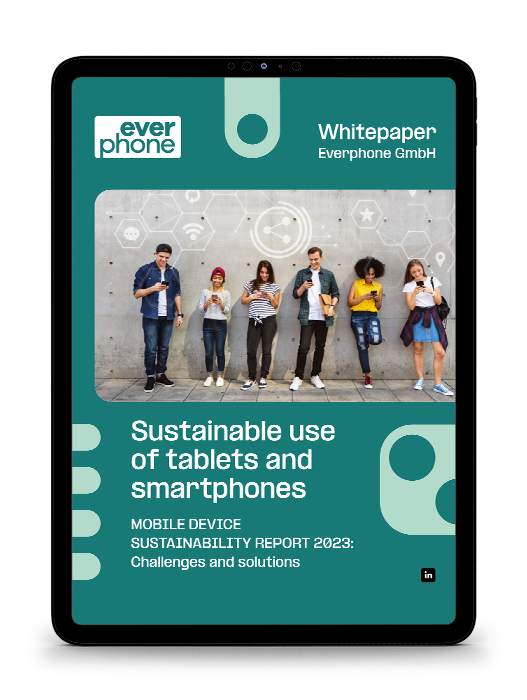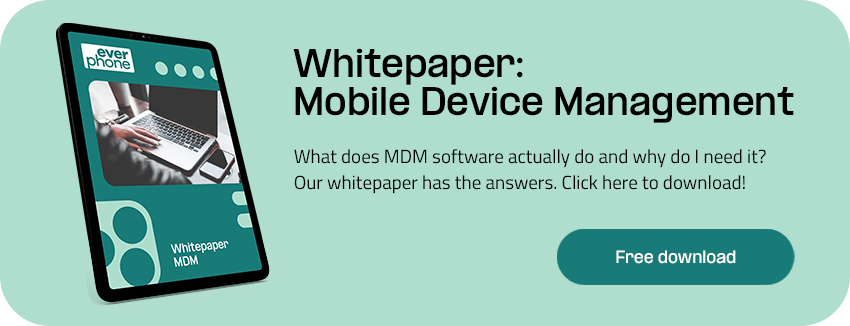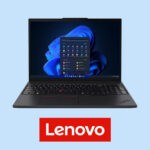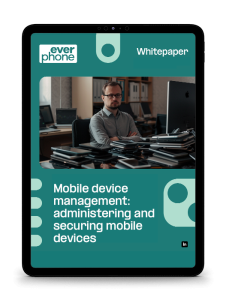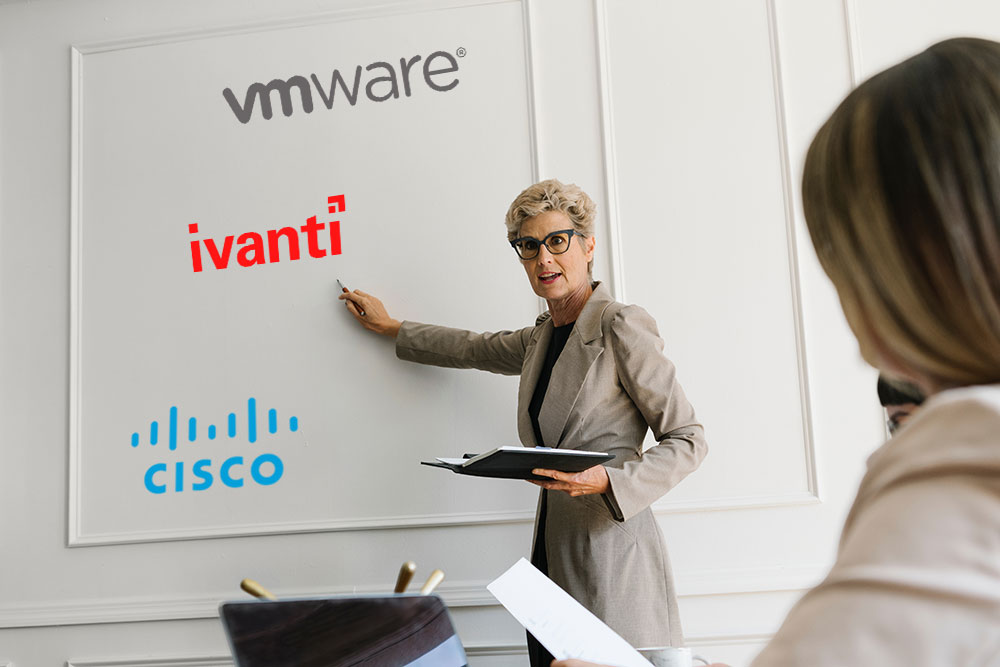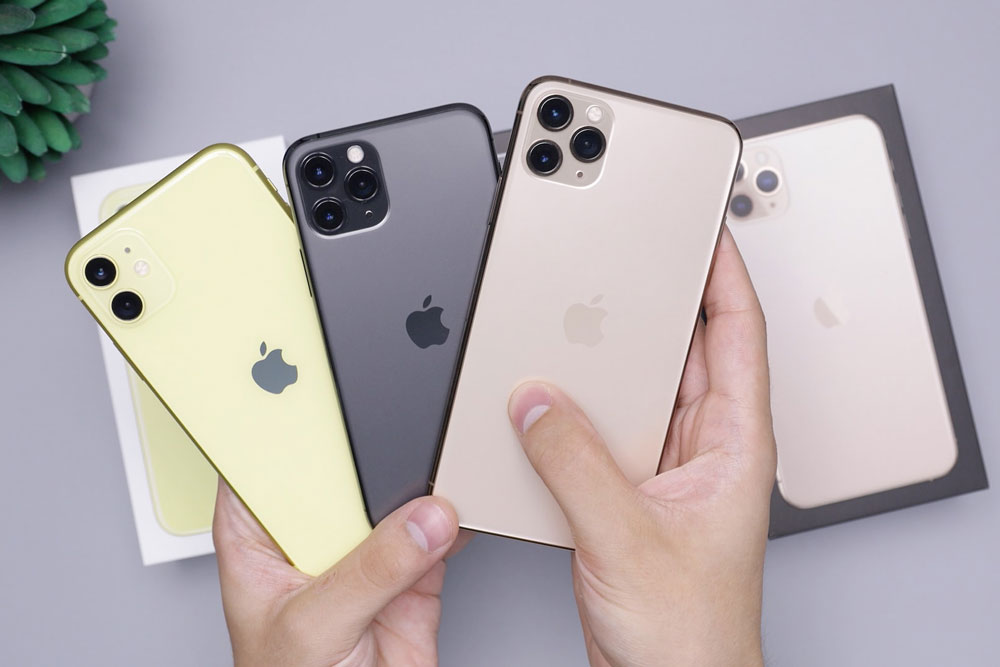Mobile Device Management is the latest buzzword in business. But what is Mobile Device Management, who supplies it, and what does it mean for your business? Below we delve into the problems facing current mobile device frameworks in the corporate context and how Sophos MDM and Everphone can help mitigate them.
What is Sophos MDM?
Sophos Mobile device management, in its simplest form, is the software-based management of mobile devices in the corporate ecosystem. Mobile devices, in this case, are not limited to smartphones but instead include any smart device that can be carried around or moved between work environments with relative ease. MDM features as a large part of the broader Enterprise Mobility Management and is implemented to address issues pertaining to mobile devices in the corporate context. These issues include everything from software management for mobile devices in a specific work environment to integrated IT and security support and the support associated with industry or entity-specific applications.
Why is a MDM important?
Mobile device management holds the key to a more integrated corporate setup, better efficiency, and higher employee engagement. Below are a few reasons why Sophos MDM is an important feature of any corporate venture.
Cost
The hardware necessary for communication is expensive. The cost of the devices and communication contracts are also ongoing. You also have to factor in the costs involved with procurement and setting devices up. Sophos Mobile Device Management helps you save money both initially and moving forward by streamlining all the above processes.
Employee sentiment
Our modern lives revolve around technology, more particularly, our smartphones. Allowing employees to use their devices within the corporate context can provide a massive morale boost. Something that would boost morale and company loyalty would be partnering with a company, like Everphone, that gives you and your employees access to state-of-the-art mobile devices.
Choosing the right mobile device management solution largely means that a separate work and personal phone is no longer necessary. Simply set up personal devices to perform the duty of a work asset while retaining its personal user ecosystem.
Corporate security
Mobile device management seeks to mitigate the inherent risks with employees bringing their personal mobile devices into the corporate ecosystem. Sophos offers numerous different approaches to securing your company data and proprietary information on employees’ personal devices.
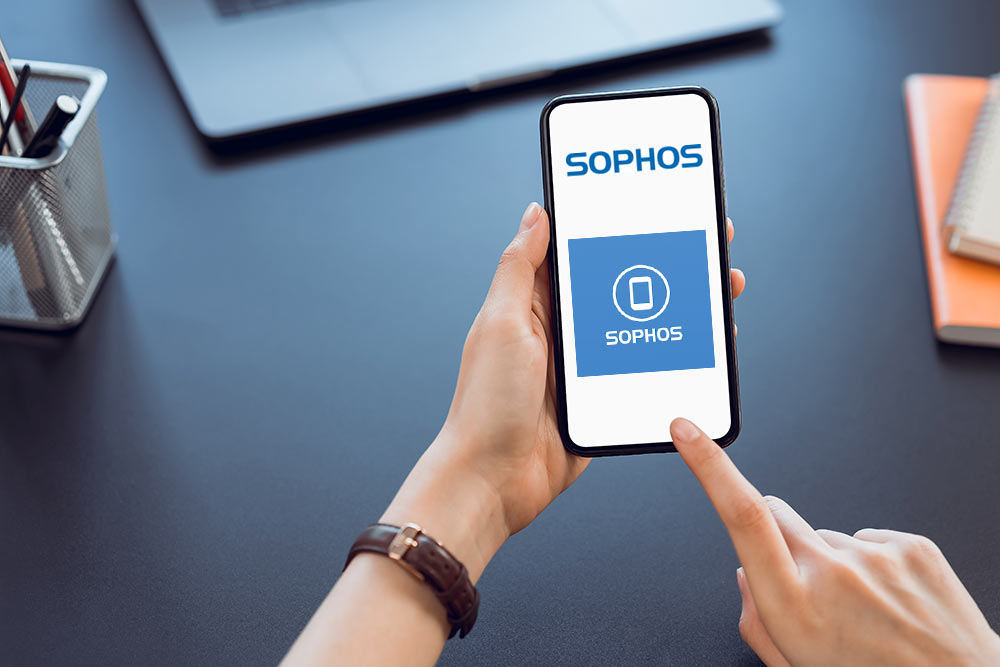
Sophos MDM: Feature overview
Split modes
Sophos supports multiple device home screens. Your employees retain full control of their personal home screen and can add, remove, and interact with apps as they wish, in addition to changing settings. On the business home screen, however, they can do only what the administrator permits.
You can decide to supply employees with a setlist of apps they’re allowed to install within the business mobile environment, or you can instead push app installations directly to the device. You can also block apps from being installed or only block certain apps from installation within this space.
You also have full control over the interactions employees’ have access to within sanctioned apps. For example, you can set up your MDM from Sophos in such a way that data can only be read or copied from certain apps and cannot be pasted or edited. You retain full control over the business home screen, and if the device is no longer needed as a corporate asset, you can institute a data wipe across the business interface remotely to safeguard information.
Container apps
Container apps work similarly to the split mode setup, except you retain full control over specific apps. The employee has full control over their personal device but cannot uninstall said apps or interact with them in ways not sanctioned by the organization.
Read more: Mobile Device Management in comparison with container apps
Kiosk mode
Kiosk mode is more for full-on corporate devices. It allows you to disable all functions of a smartphone, bar those you need. For example: If you need a device to act only as a barcode reader or recorder, you can disable every other function the device performs, including the home screen, browsers, settings interface, and device lock.
In the case of any of the above modes, you can remotely control, interact with, and wipe devices to protect corporate information.
Mobile devices in the corporate context
Mobile devices and the use thereof in the corporate setting are rife with conflicting opinions. There are those in the corporate world who are for the mobile device revolution that has taken hold of a massive chunk of the modern corporate setup, and there are those who stand firmly opposed. Opinions, however, aren’t the basis upon which anyone should build or expand their business. Let’s instead examine the facts.
Over 81% of the United States population owns a smartphone. The key difference between a smartphone and the previously revolutionary feature phone is that a smartphone can connect to the internet. This is a clear indication of where the free world’s communication priorities lie. We want to be connected.
The chief complaint from the vocal camp against smartphones in the workplace is that it decreases productivity. While there’s merit to the notion that, if given a chance, employees would rather be messing around on social media during work hours, there are also relatively easy ways to get around it.
Mobile device management incorporates many tools geared toward increasing productivity. To that end, here are a few ways that successful implementation of mobile devices in the corporate ecosystem could boost productivity:
- With more mobile devices in the workplace, management can cut down on face-to-face meetings. These are often mismanaged and unnecessary.
- Mobile devices open up the opportunity for real-time messaging and quicker decision-making and alignment.
- They also bridge the gap between workers in the field and those at the office.
- File sharing on the go also becomes a reality with everyone connected through a network of mobile devices.
- Instant access to analytical apps and tools to collect data on employee engagement, management efficacy, and weak points within the organization. This can lead to better data-driven decision-making.
Even though there are numerous benefits to fostering a healthier relationship with mobile devices within the corporate context, there are also many dangers in terms of security, confidentiality, and unregulated access to company information. Therefore it’s imperative to implement a mobile device management framework such as what Sophos offers if you intend to bring mobile devices into your corporate setup.
BYOD: What is “bring your own device”?
Bring Your Own Device is a corporate trend allowing the use and organizational network integration of employees’ personal mobile devices. For many companies, BYOD seems to be one of the best ways to deal with the current rise in remote workers and the fundamental changes that Covid-19 forced upon the corporate landscape.
The BYOD trend allows for more flexible scheduling, connecting on the go, and creates a basic support framework for employees working from home. Many companies already have some kind of BYOD framework and sanction its inclusion in the corporate context, but some still see it as a part of ‘shadow IT.’ This refers to hardware and software not directly supported by an organization’s IT department.
The problem with BYOD
Numerous problems could come up when the BYOD trend is integrated into your corporate landscape. The way BYOD works is that employees’ devices connect with the various systems, frameworks, and sharing platforms your organization employs.
This means you potentially give unregulated devices unbridled access to your information and data stores. Additionally, as soon as private devices become corporate assets through containerization or simply access to corporate platforms, the company needs to get involved with the security, monitoring, updates, and permissions of each device. This could mean a massive outlay of IT resources.
If your organization has specific software or applications that then need to be installed on each device, your IT department needs to make allowance for different operating systems, such as iOS and Android, and then even further considerations for different versions of each operating system. Not every device brought into the workplace under BYOD will be the same.
In an ideal circumstance, your employees will all have relatively up-to-date mobile device plans and therefore be running new software such as Android 11 or iOS 15. The more likely scenario is that some in your employees will have slightly outdated devices. Android 7, for example, is still a fairly competitive version; however, Android 4.4 and 5 are still in use. The same goes for iOS; while the dream is for everyone to have access to an iPhone 13, those who have iPhones may still be using an older model such as the iPhone 6 or X.
The thing about mobile software is that apps optimized for Android 11 won’t work as well, or at all, on Android 4.4. The same goes for iOS. Then, there are the additional operating systems such as ColorOS, ChromeOS, and Windows Phone. While ChromeOS and ColorOS use Google’s Android OS as a base, there are minor differences in their layout, capabilities, and synchronization with each other.
You’ll need an IT team well versed in all the above mobile operating systems and more. They’ll need to know the latest updates and changelogs, bugs that each OS is prone to experience, known security issues of each OS, and you’ll need to have your corporate apps ported to all these operating systems and their various versions. That is just concerning mobile phones and tablets. As soon as you integrate personal laptops into the corporate space, you have more operating systems and versions to deal with:
- Microsoft’s Windows 11, 10, 8, 8.1, and possibly even 7.
- Chromebooks run on Google’s ChromeOS for desktop devices.
- Macbooks run on macOS.
- Linux is still popular as a desktop OS.
- Ubuntu is less popular but still in use.
You also have to take into account that not all laptops are made equal, and while the dream is to have your entire corporate ecosystem running on a MacBook Pro, the reality is that some may still have an Acer Aspire from 2015. Then there’s the issue of processors; Intel Core i3, i5, and i7. These three versions are very different in their processing power and output. You’d have to optimize any work resources you use to the lowest version your employees have and simultaneously make sure it works well on the higher-end devices scattered amongst your workforce.
Everphone – Device as a Service
We’ve covered the numerous issues with the entire BYOD framework; now, let’s discuss a solution. Everphone switches out the difficult to manage and arduous to execute BYOD method for the far easier and more convenient CYOD – Choose Your Own Device.
In the previous passage, we discussed the ideal situation of your entire staff complement conducting business on the latest tech. With Everphone, that’s no longer a hypothetical, idealized situation, but rather Standard Operating Procedure. CYOD eliminates the need for larger IT teams with expertise scattered across too many operating systems and related versions.
You’ve heard what they say about Jack of all trades? CYOD gives your IT department the chance to become a master at selected operating systems, brands, and even devices, allowing you to discard support for less popular choices.
{% video_player “embed_player” overrideable=False, type=’hsvideo2′, hide_playlist=True, viral_sharing=False, embed_button=False, autoplay=False, hidden_controls=False, loop=False, muted=False, full_width=False, width=’1920′, height=’800′, player_id=’66042714508′, style=” %}
You also have the chance to streamline your entire mobile asset retinue. Under the Phone as a Service and CYOD service, you, as the administrator, can select a base device, platform, operating system, or even its version, and your employees will be able to choose any device associated with that filter.
This means your staff gets to choose the devices they want to work on, as long as they meet your criteria and industry or organization-specific demands.
If the idea of a broader device choice isn’t what you have in mind for mobile device integration, Everphone also offers the classic rental option. With this product, you as the administrator choose the device model you’d like your staff to work on, and you have the option to stick within your budget with slightly more inexpensive device solutions.
Read up on MDMs:
Choose productivity-choose Everphone
Integrating your existing or future MDM service with Everphone means an even more streamlined ecosystem. We give you free rein in terms of device choices for your employees. You choose the parameters, budget, and what you need the devices to be capable of doing, and we’ll provide you with suitable devices. We also manage the devices. We’ll take care of the condition of the devices and provide you with timely replacements should you need them. Choosing our CYOD service means you and your employees have access to the latest tech while controlling your budget and specific requirements.
MDM by Sophos then gives you complete control over the finer points of what your devices from Everphone can do. You choose the apps, the functions, and the user cases, while Sophos handles the implementation, rollout, and onboarding. They also manage your mobile security profile, leaving your IT department to focus on that of your company as a whole. So, in conclusion: We at Everphone provide you with suitable mobile device solutions, Sophos takes care of device management, and you retain full control of access rights, user policies, and data distribution. So choose Everphone, for more productive, integrated, and streamlined mobile device integration in the corporate context.
